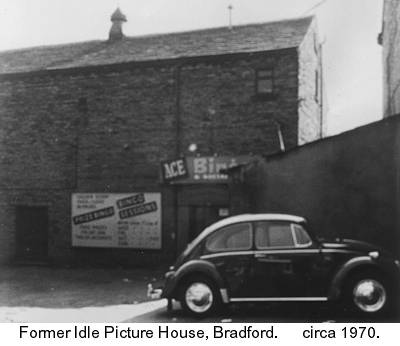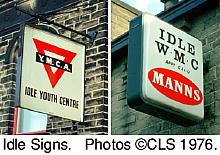Idle Picture House
The Green/Bradford Road,
Idle, Bradford.
 Quick links to other sections on this page . . .
Quick links to other sections on this page . . .

Pre-History
The first films to be shown in Idle, apart from a bioscope sideshow at the Idle Tide by travelling showmen, was in the Co-op Hall at the bottom of the High Street where it meets The Green.
The hall was on the upper (second) floor and accessed by a stone staircase at the rear (Hampton Place) of the building. The Co-op were pioneers in cinema in their Co-op meeting halls across the north. This building still stands, as does the rear staircase, but the hall has been converted into flats with access via the same rear staircase.
It was the success of these shows which led to the setting up of the Idle Picture Palace nearby though the Co-op continued up to the start of World War I in 1914 with films and increasingly promotional films for its own products and services.

Location
Almost hidden away behind shops and houses with access between two buildings on the eastern side near the bottom of Bradford Road or though a narrow passageway between shops on the southern side at the point where Albion Road joins The Green from which it takes its address. The cinema building running north-south almost parallel with Bradford Road.

The Building
Part of the former Green Mill whose chimney once overshadowed The Green until it was dismantled brick by brick. The former mill was the home to the Salvation Army at the end of the 19th century then had been used as a brass foundry and art metal works. The conversion to a cinema in late 1911 was quite simple and functional. The building of plain rectangular stone construction with pitched roof of stone slates with entrance at its south-west end facing towards Bradford Road.

Interior
The small wood-panelled entrance lobby had a paybox and polished wood staircase leading to the small stepped balcony and projection room positioned centrally at the rear.
The auditorium with a flat floor downstairs and approx. 500 seats, the screen - actually a sheet - was mounted on the north wall. Later a papered screen flat up to the wall and a lantern slide with a white dot on the curtains was the cue to manually open.

The Opening
The proprietor and manager was Colville Dyke who opened his new Idle Picture Palace on Friday 12th January 1912 with . . .
"The Doomed Ship" - 1911 USA B/w Silent.
Starring Charles Sutton, Mabel Trunelle and James Gordon.
and supporting short films.
Popular Prices 2d to 1/-d.
Programme changed Mondays and Thursdays
Dyke's Perfection Pictures.
Later Tom Thornton took control of the Idle Cinema Co (T & J Thornton) with M. Mitchell as resident manager who proudly advertised in the Shipley Times & Express in 1920 . . .
The Little Show with Big Pictures
Proprietor - T. Thornton.
The hall for clean, bright and
mirth making pictures.
Why go to the City when you can
see the BEST PICTURES HERE?
Don't fail to hear our new pianist.
Come early and secure your seat.
Seats booked in advance (balcony only).
The cinema was referred to locally as "Thornton's" after its well known proprietor. Tom Thornton was also involved with the Oak Lane cinema and the Thornton Mechanics cinema.
In those early days a somewhat temperamental gas engine provided the power for the two projectors.

Talkies
Circa 1930 and now under the control of J and F Thornton with Fred Thornton as manager, the British Acoustic (BA) sound system was installed. As the screen was mounted directly on the wall, it was necessary to place the horn speaker box to one side of the screen. Prices were now 4d to 9d.
In 1932 the tip-up seating was 289 in the stalls and 128 in the balcony - total 417. Stalls seats arranged in two blocks with one aisle offset to the left of centre. The front row was 17feet 9inches from the screen. By 1945 seating was reduced to stalls 284 and balcony 128 - total 412. Capacities taken from Council licensing records. [The KYB record shows 700 seats for 1935 which seems a gross overestimate.]
In 1951 prices had risen to "Balcony 1/3d bookable at no extra; Back Stalls 10d and Front Stalls 6d". It was "Monday to Friday continuous from 6.15pm, Saturdays and Holidays 6.15 and 8.30pm" with three programme changes per week.

CinemaScope
Circa 1955 and mounted in front of the original screen, the CinemaScope wide screen was installed with a loudspeaker at each side but wired for mono sound. A former projectionist recalls in 1955, with Ned North in control, the old rear shutter GB projectors with low intensity arcs and British Acoustic (BA) sound set. For CinemaScope it used second-hand GB-Kalee Vulcan arcs and Kalee anamorphic lenses fitted. The cinema had a 75amp generator and Hewittic mercury arc rectifier.

Closure
The Idle Picture House closed on Saturday 7th February 1959 with the final film . . .
"The Silent Enemy" - 1958 GB B/w 112 mins.
Starring Laurence Harvey, Dawn Addams and Sidney James.
The nearest cinemas were now Greengates which closed two months later in April 1959 and the Regal at Five Lane Ends which lasted until November 1966.
The former Idle cinema building re-opened in 1961 as the Ace Bingo Club. The premises were later demolished around 1970/71 and retirement flats now occupy the site.

For many, many years the suburban village of Idle was the butt of many jokes about its name on radio/TV and national newspapers and with visitors.
There really was an Idle Youth Centre and there still is the, now quite famous, Idle Working Mens Club.
Copyright ©2007, Colin Sutton.
May not be copied or reproduced without permission.

Return to Bradford Cinemas History Index Page.
| 
